The 10 Biggest Ports in the World: Ranking and Analysis for 2025
- Dushyant Bisht

- Aug 9
- 8 min read
Updated: Nov 12

Introduction
Shipping ports are the indispensable arteries of our global economy, the bustling hubs where nations and continents connect. They are far more than just docking areas for ships; they are immense maritime facilities that facilitate over 90% of global trade by volume and 70% by value. Their economic, social, and geopolitical significance in the modern world is unparalleled. Port operations dictate the speed of supply chains, influence the cost of goods, and serve as crucial indicators of a nation's economic health.
This blog post will provide a comprehensive, data-driven overview of the biggest ports in the world. We will explore their core functions, the country that dominates the global port ranking, and present a detailed analysis of the top 10 busiest container ports for 2025. By understanding these giants of global trade, you gain a clearer picture of the intricate network that underpins our world.
What Is a Shipping Port?
A shipping port is a maritime facility strategically located with wharves or loading areas where ships dock to load and discharge cargo and passengers. These critical hubs can be found on coastlines, estuaries, or even inland, connected to the sea via rivers or canals.
The various types of shipping ports each serve a distinct purpose:

Seaports are located on coastlines, directly accessing the sea for large-scale international trade.
Inland Ports are situated on rivers or canals, linking to the sea via connecting waterways, such as the Port of Hamburg in Germany.
Fishing Ports are designed specifically for fishing vessels, supporting local and international seafood trade.
Cruise Ports cater to passenger cruise ships, acting as a primary driver for a region's tourism economy, such as Nassau in the Bahamas.
Cargo Ports specialize in handling specific types of goods, including containerized, bulk (e.g., oil, coal), or breakbulk cargo (e.g., machinery).
Every port relies on key components to function efficiently. This includes berths where ships dock, terminals for cargo handling and storage, navigation channels to ensure safe ship entry and exit, and a vast network of supporting infrastructure like warehouses, cranes, and transport links (roads, railways).
What Are Shipping Ports Used For?
Shipping ports serve a variety of critical functions that are essential for global commerce.
Their primary functions revolve around:
Cargo Handling: This involves the highly organized and efficient process of managing the loading and unloading of containers, bulk cargo, and other goods.
Passenger Transport: Ports also act as gateways for tourism and travel, supporting a thriving cruise ship and ferry industry.
In international trade, ports are indispensable. They are the gateways for importing and exporting goods, seamlessly connecting global supply chains. Ports also facilitate transshipment, a process where cargo is transferred between ships for further transport, serving as a critical node in a larger logistical network.
According to industry reports, approximately 70% of global merchandise trade by value passes through ports, underscoring their profound economic impact. Beyond trade, some ports also serve as military ports for naval operations, support fishing industries, or handle raw materials for industrial sectors like oil, gas, and manufacturing.
What Country Has The World's Largest Shipping Ports?
The answer is unequivocally China. Due to its massive manufacturing base, high export volumes, and strategic location along key international trade routes, China hosts the largest and busiest shipping ports in the world. Chinese ports collectively handle over 257 million TEU annually, a figure that reflects their undeniable dominance in global trade.
The top ports in China alone rank among the world's busiest:
Port of Shanghai: The world’s busiest port, handling over 49 million TEU in 2023.
Port of Ningbo-Zhoushan: Known for deep-water facilities, handling 35.30 million TEU in 2023.
Port of Shenzhen: A key hub for electronics exports, processing 29.88 million TEU in 2023.
Port of Guangzhou: Vital for southern China’s trade, handling 25.41 million TEU in 2023.
Port of Tianjin: Serves northern China, with 22.19 million TEU in 2023.
These statistics highlight China’s critical role in global commerce and its investment in world-class port infrastructure.
The Complete List of the Top 10 Biggest Ports in the World
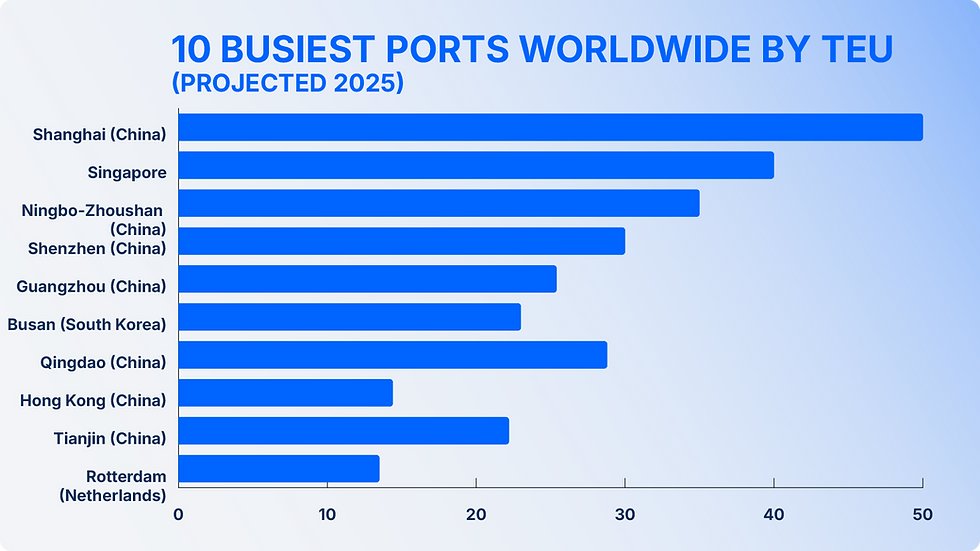
Global maritime trade relies heavily on the world's busiest ports, which serve as critical gateways for international commerce. These massive logistics hubs handle millions of containers annually, facilitating the movement of goods that power the global economy. Based on the latest available data through 2024, here is the definitive ranking of the top 10 biggest ports in the world by container throughput, measured in Twenty-foot Equivalent Units (TEU).
1. Shanghai, China
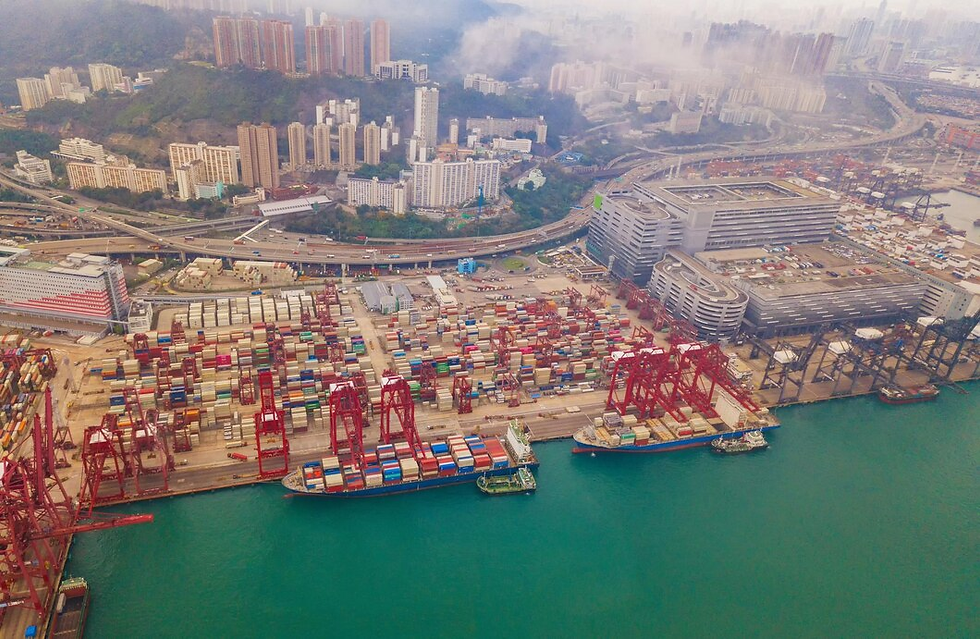
Leading the global rankings for over two decades, Shanghai maintains its position as the world's busiest port with a capacity of over 49 million TEU. The port started 2024 strong, reaching 76.7 million TEU in the first quarter alone, marking a 10% increase compared to the previous year. Located strategically in the Yangtze River Delta, Shanghai serves as China's primary gateway to global markets and houses the world's largest automated container terminal. The port's extensive network connects to over 200 countries and regions worldwide, making it an indispensable hub for international trade.
2. Singapore, Port

As Asia's premier transshipment hub, Singapore processed approximately 39 million TEU in recent data. This island nation's port connects over 600 ports globally across 123 countries, positioning itself as the maritime crossroads of Asia. Singapore has established itself as a leader in smart port technology and digital innovation, implementing advanced automation systems and sustainable practices that set industry standards worldwide.
3. Ningbo-Zhoushan, China

Ningbo Port is one of the busiest in the world, with an annual container throughput of more than 30 million TEUs. The port's total cargo throughput was 1.12 billion tons, putting it first globally for 11 years. This massive port complex is renowned for its exceptional deep-water facilities and extensive rail and highway connections to China's manufacturing heartland. The port operates 24/7, working with the latest technologies along with automated equipment, ensuring efficient cargo handling and processing.
4. Shenzhen, China

Processing approximately 30 million TEU annually, Shenzhen serves as a crucial gateway for China's electronics and high-tech manufacturing sector. The port boasts state-of-the-art terminals and has invested heavily in automation and digitalization. Its proximity to Hong Kong and position in the Pearl River Delta makes it a vital link in global supply chains, particularly for manufactured goods destined for international markets.
5. Guangzhou Harbor, China
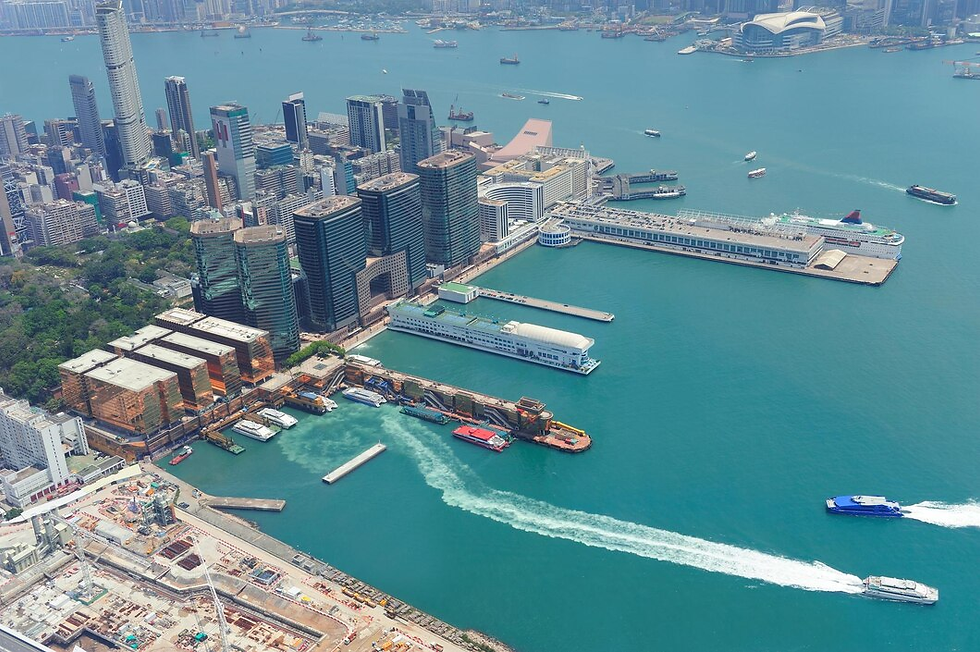
Located in the Pearl River Delta, Guangzhou handled approximately 25 million TEU in recent measurements. This ancient trading port has transformed into a modern logistics powerhouse, serving as a vital gateway for southern China's export-oriented economy. The port's strategic location provides excellent access to China's manufacturing regions and serves as a key distribution point for goods throughout Asia.
6. Qingdao, China
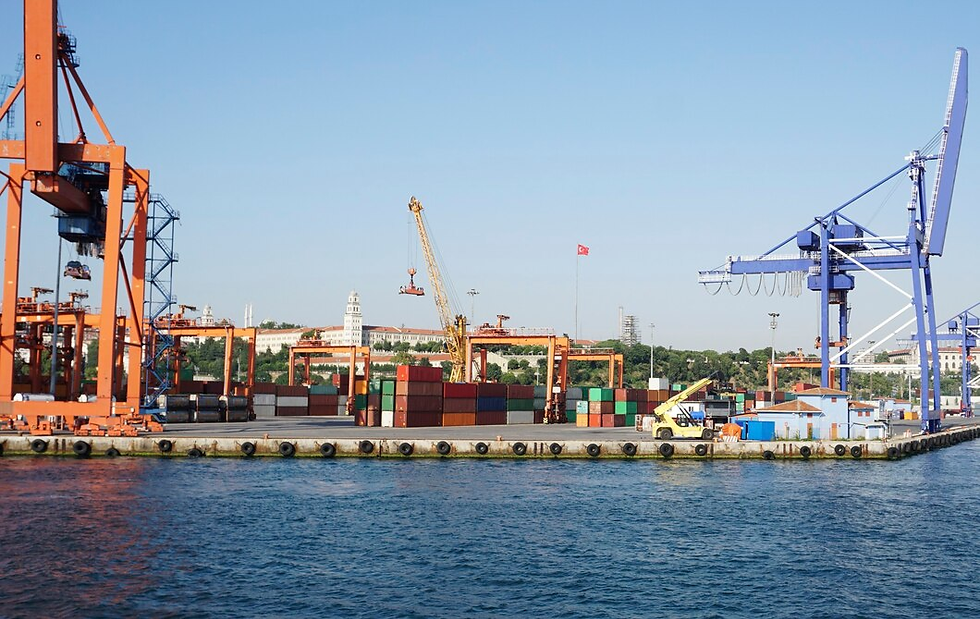
With approximately 29 million TEU in throughput, Qingdao represents a crucial node in China's Belt and Road Initiative and Maritime Silk Road. Located in Shandong Province, this port serves as northern China's primary gateway to international markets. The facility has undergone significant modernization, featuring advanced container handling equipment and comprehensive logistics services.
7. Busan, South Korea

As Northeast Asia's major transshipment hub, Busan processed approximately 23 million TEU, playing a pivotal role in the region's logistics network. The port serves as a critical gateway for trade between Asia and other continents, offering excellent connections to major shipping routes across the Pacific. Busan has invested significantly in green technologies and smart port initiatives.
8. Tianjin, China
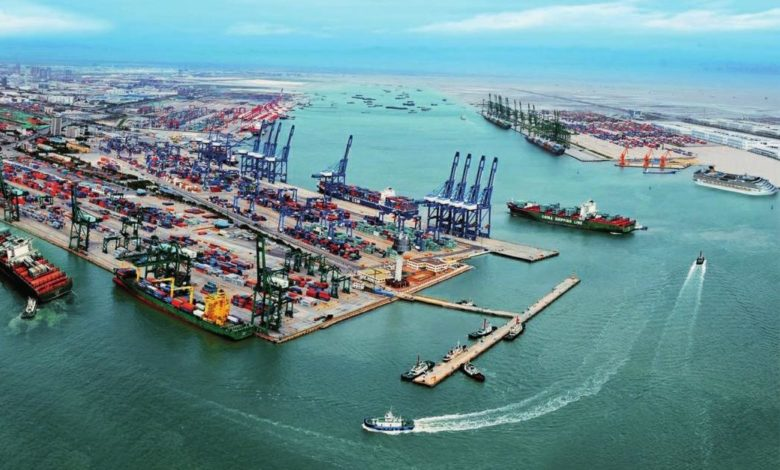
Handling approximately 22 million TEU, Tianjin stands as northern China's largest artificial port. Serving the Beijing-Tianjin metropolitan area, this port plays a crucial role in China's industrial and commercial activities. The facility has expanded significantly in recent years, developing specialized terminals for various cargo types and implementing advanced logistics systems.
9. Hong Kong, S.A.R, China

Despite facing increased competition from mainland Chinese ports, Hong Kong remains a major deep-water port, processing approximately 14 million TEU. The port continues to serve as a crucial hub for high-value manufactured goods and maintains its position as a premium logistics center, though its ranking has declined as mainland Chinese ports have expanded their capabilities.
10. Rotterdam, The Netherlands

As Europe's largest port, Rotterdam handled approximately 13.5 million TEU, cementing its position as the continent's primary gateway. The Dutch port is celebrated for its sophisticated logistics network, advanced digitalization, and commitment to sustainability. Rotterdam serves as a crucial distribution hub for goods entering Europe and has pioneered numerous innovations in port automation and environmental stewardship.
Top 5 Busiest Ports by TEU (2023 Data)
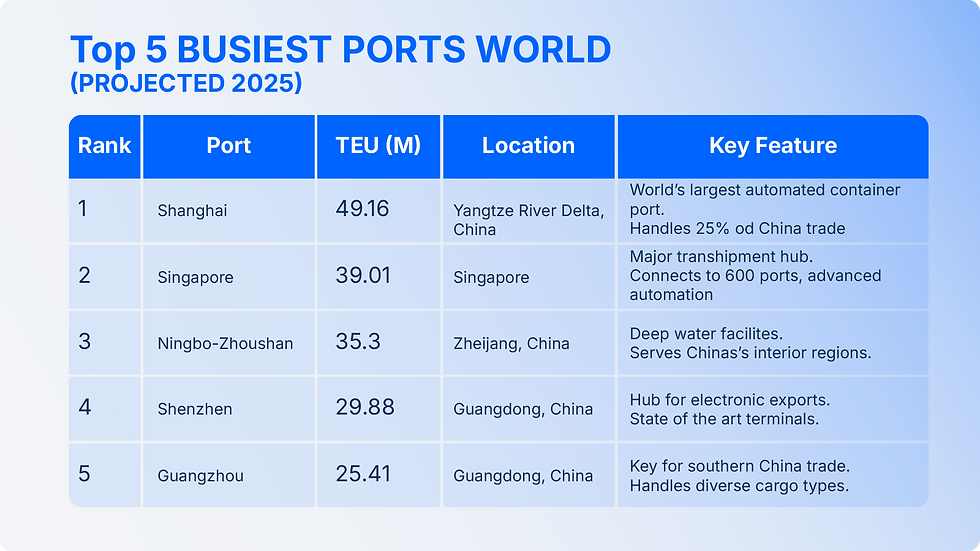
Rank | Port | TEU (Million) | Location | Key Features |
1 | Shanghai, China | 49.16 | Yangtze River Delta | World’s largest automated container port, handles 25% of China’s trade. |
2 | Singapore | 39.01 | Singapore | Major transshipment hub, connects to 600 ports, advanced automation. |
3 | Ningbo-Zhoushan, China | 35.30 | Zhejiang, China | Deep-water facilities, serves China’s interior regions. |
4 | Shenzhen, China | 29.88 | Guangdong, China | Hub for electronics exports, state-of-the-art terminals. |
5 | Guangzhou Harbor, China | 25.41 | Guangdong, China | Key for southern China trade, handles diverse cargo types. |
In terms of cargo tonnage, the numbers are equally staggering. Shanghai handles 744 million tonnes annually, while Singapore processes 537.6 million tonnes (Source: Marine Insight, verify latest figures). This demonstrates the sheer volume and scale of operations at these global chokepoints.
The Future of Ports in a Changing World
Shipping ports will remain critical nodes in the global economy, but their role is evolving. The future of these facilities is centered on technology, sustainability, and expansion to meet the demands of a rapidly changing world.
Future Trends:
Increasing Automation and Digitization: Ports are investing heavily in technologies like AI, robotics, and smart port systems to optimize operations, reduce human error, and improve efficiency. Shanghai’s Yangshan Deep Water Port, the world's largest automated container port, is a prime example of this trend.
Sustainability: There's a growing emphasis on green initiatives, including the adoption of cleaner fuels, electrification of port equipment, and adherence to programs like the World Port Sustainability Program to reduce environmental impact.
Expansion and Modernization: Ports are continuously expanding to accommodate ever-larger vessels and increasing trade volumes, a trend exemplified by Singapore’s Tuas terminal, which is being developed to handle up to 65 million TEU annually by 2040.
As the arteries of global trade, shipping ports will continue to evolve, becoming smarter, greener, and more efficient. Understanding the crucial functions and scale of these global hubs provides invaluable insight into the health of the world economy.
Disclaimer:
This material is provided for informational purposes only and does not constitute financial, investment, or legal advice. All digital assets carry inherent risks, including potential loss of capital. Past performance is not indicative of future results. Please review the relevant offer and risk disclosures carefully before making any financial decision.
FAQs for Busiest Port in world
Why are ports so important for the global economy?
Ports are critical because they are the gateways for international trade, facilitating the import and export of goods. They handle approximately 70% of global merchandise trade by value, connecting supply chains and driving economic growth.
Which country has the largest and busiest shipping ports?
China has the largest and busiest ports in the world. Due to its massive manufacturing base and high export volumes, ports like Shanghai, Ningbo-Zhoushan, and Shenzhen consistently dominate global rankings by container throughput (TEU).
What does TEU stand for in port rankings?
TEU stands for "Twenty-foot Equivalent Unit." It is a standard unit of measurement used to count the capacity of a container ship or the volume of cargo handled by a port, with one TEU being equivalent to one standard 20-foot long container.
What is the difference between a port and a harbor?
A harbor is a natural or man-made body of water sheltered from the sea, where vessels can seek refuge. A port is a maritime facility built within a harbor or along a coast that includes terminals, berths, and infrastructure for the commercial activity of loading and unloading cargo and passengers.
How is technology changing modern shipping ports?
Technology is transforming ports through automation (e.g., robotic cranes), digitalization (e.g., blockchain for documentation), and data analytics (e.g., AI for traffic optimization) to improve efficiency, security, and sustainability.


